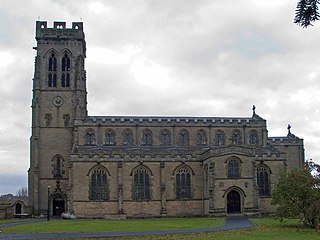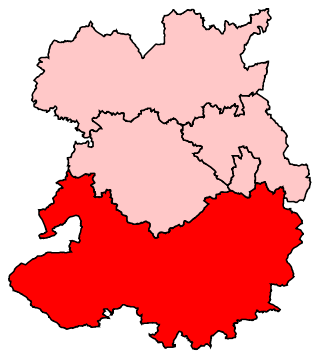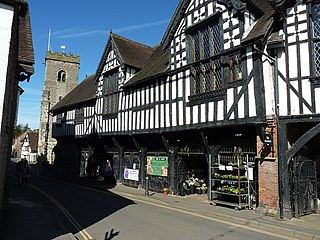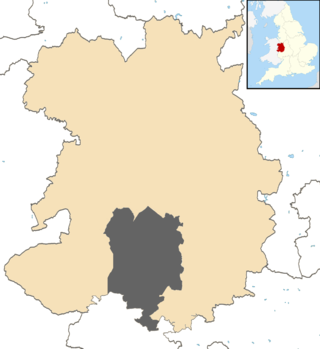
Shropshire is a ceremonial county in the West Midlands of England, on the Welsh border. It is bordered by Wrexham County Borough and Cheshire to the north, Staffordshire to the east, Worcestershire to the south-east, Herefordshire to the south and Powys to the west. The largest settlement is Telford, and Shrewsbury is the county town.

Wellington is a constituent market town of Telford and a civil parish in the borough of Telford and Wrekin, Shropshire, England. It is situated 3 miles (4.8 km) northwest of Telford town centre and 12 miles (19 km) east of Shrewsbury. The summit of The Wrekin lies 3 miles southwest of the town. The population of the town was 25,554 in 2011.
Shropshire was established during the division of Saxon Mercia into shires in the 10th century. It is first mentioned in 1006. After the Norman Conquest it experienced significant development, following the granting of the principal estates of the county to eminent Normans, such as Roger De Montgomery and his son Robert de Bellême.

Broseley is a market town in Shropshire, England, with a population of 4,929 at the 2011 Census and an estimate of 5,022 in 2019. The River Severn flows to its north and east. The first iron bridge in the world was built in 1779 across the Severn, linking Broseley with Coalbrookdale and Madeley. This contributed to the early industrial development in the Ironbridge Gorge, which is now part of a World Heritage Site.

The Wenlock Olympian Games, dating from 1850, are a forerunner of the modern Olympic Games. They are organised by the Wenlock Olympian Society (WOS), and are held each year at venues across Shropshire, England, centred on the market town of Much Wenlock. One of the two mascots for the 2012 Summer Olympics was named Wenlock in honour of the Wenlock Olympian Games.

Ludlow is a constituency in Shropshire represented in the House of Commons of the UK Parliament since 2005 by Philip Dunne, a member of the Conservative Party.

Madeley is a constituent town of Telford and a civil parish in the borough of Telford and Wrekin, Shropshire, England. The parish had a population of 17,935 at the 2001 census.
The geology of Shropshire is very diverse with a large number of periods being represented at outcrop. The bedrock consists principally of sedimentary rocks of Palaeozoic and Mesozoic age, surrounding restricted areas of Precambrian metasedimentary and metavolcanic rocks. The county hosts in its Quaternary deposits and landforms, a significant record of recent glaciation. The exploitation of the Coal Measures and other Carboniferous age strata in the Ironbridge area made it one of the birthplaces of the Industrial Revolution. There is also a large amount of mineral wealth in the county, including lead and baryte. Quarrying is still active, with limestone for cement manufacture and concrete aggregate, sandstone, greywacke and dolerite for road aggregate, and sand and gravel for aggregate and drainage filters. Groundwater is an equally important economic resource.

Beckbury is a village and civil parish in Shropshire, England. Beckbury had a population of 327 according to the 2001 census, increasing to 340 at the 2011 Census, The village is 8 miles (13 km) south-east of Telford and is close to the Staffordshire border. The small rural parish of Beckbury lies on the Shropshire–Staffordshire border 3.7 miles (6 km) south of Shifnal. It has a pub – the Smokey Cow, a Church of England school, a village hall, and a parish church dedicated to St Milburga.

William Penny Brookes was an English surgeon, magistrate, botanist, and educationalist especially known for founding the Wenlock Olympian Games, inspiring the modern Olympic Games, and for his promotion of physical education and personal betterment.

Rushbury is a village and civil parish in Shropshire, roughly five miles from Church Stretton and eight miles from Much Wenlock.

Caughley was a non-nucleated settlement situated two kilometres east of Barrow near Much Wenlock in Shopshire, England, with the River Severn running down its eastern edge and Dean Brook along its south-western edge. It is noted as a site of the production of Coalport porcelain. In 1883, Caughley extended to 332 hectares and in 1931 the population of the township stood at 48.

The Much Wenlock Guildhall is a guildhall located on Wilmore Street in Much Wenlock, Shropshire. It is a Grade II* listed building.

Munslow is a hundred of Shropshire, England. It was formed with the amalgamation of the Anglo-Saxon hundreds of Patton and Culvestan during the reign of Henry I. Hundreds in England had various judicial, fiscal and other local government functions, their importance gradually declining from the end of manorialism to the latter part of the 19th century.
Culvestan was a hundred of Shropshire, England. Formed during Anglo-Saxon England, it encompassed manors in central southern Shropshire, and was amalgamated during the reign of Henry I with the neighbouring hundred of Patton to form the Munslow hundred.

Bourton is a small village in Shropshire, England, 3 miles (5 km) southwest of Much Wenlock. It is part of the civil parish of Much Wenlock.

The Corn Exchange is a commercial building in the High Street in Much Wenlock, Shropshire, England. The structure, which is currently used as a library, is a Grade II listed building.



















